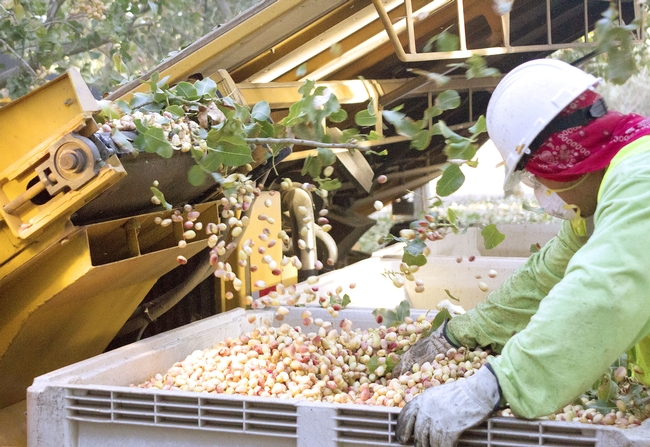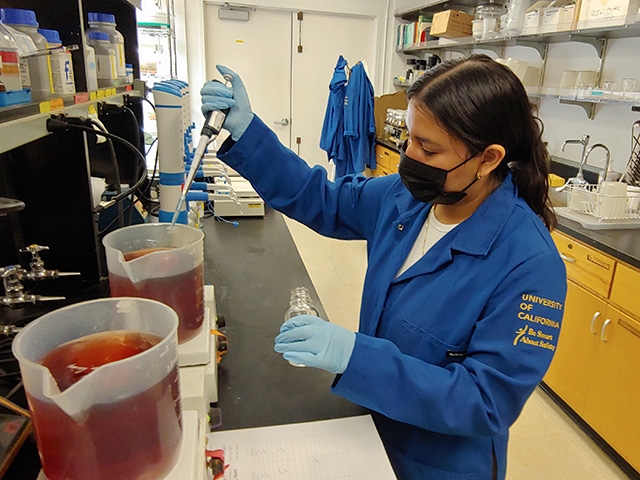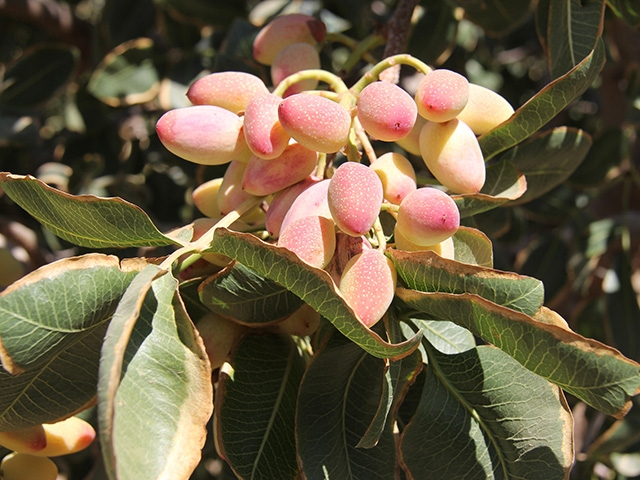
Posts Tagged: Louise Ferguson
NIFA funds $3.8 million project to find climate-resilient pistachio trees
Growers invited to participate in study by sharing their experiences
A multi-state team led by Patrick J. Brown has been awarded nearly $3.8 million over the next four years for a project to improve pistachio production as the industry faces warmer winters and scarcer water.
“We are at this unique point in history where we can do this,” said Brown, an associate professor in the UC Davis Department of Plant Sciences.
The project aims to ensure the industry can thrive in coming decades despite the challenges faced. Growers are invited to participate in the study, sharing what they already are trying in their own fields or supporting any aspect of the project. To discuss the possibilities, contact Brown at pjbrown@ucdavis.edu or (530) 752-4288.
The project includes research to ensure pollination, experiments to calculate irrigation needs amid water shortages, creating tools to improve public breeding programs, developing more efficient harvesting equipment, and economic analyses to ensure future pistachio cultivation is economically rewarding. Researchers hope to offer a guide for growers deciding whether to plant new orchards or remove existing ones.
“The success of California's pistachio industry, which is the top producer of the nuts in the world, has always relied on a strong collaboration between UC researchers and pistachio growers,” said project participant Florent Trouillas, a UC Cooperative Extension specialist in the UC Davis Department of Plant Pathology. “Research efforts must continue to address enduring and new challenges, improve sustainability and ensure the profitability of pistachio farming.”
The tasty, green nuts have blossomed into a $5.2-billion industry in California, thanks to their greater tolerance of dry lands and salty soils. The project aims to further improve their climate resilience by finding a rootstock that can thrive despite growing water scarcity and declining water quality projected over the next half-century. With millions of genetically distinct pistachio trees growing in the state, "we already have out there what may be the industry's next great rootstock," Brown said. "It's probably in some grower's field already. We just have to find it."
Researchers seek to pair that new rootstock with high-yielding scions – the producing part of the tree grafted onto the rootstock – to develop new combinations that can thrive in the different conditions across the state.
Trouble with “boy meets girl”
Pistachios, like many other tree crops, have male and female trees, and they require hundreds of hours of wintertime temperatures below 45 degrees Fahrenheit for the trees to flower in the spring. Wind blows the pollen from male flowers to female flowers, creating nuts.
Complicating the timing: Boy flowers and girl flowers generally require different amounts of winter cold to bloom. After a sufficiently cold winter, boys and girls flower together. But if the winter is warm, most of them will flower at different times, reducing pollination.
That happened in the winter of 2014-15, which saw unusually warm winter temperatures. The following fall, farmers harvested only half their expected crop, losing more than $1 billion, Brown said. Climate change is expected to provoke progressively warmer winters in the future, on average.
An additional complication: The boy scions come from a single variety, or cultivar, and the girl scions come from another single cultivar. "In California part of the problem is that we have been relying on a single male and single female cultivar," Brown explained.
A key part of this project will be to test new scions that can pollinate efficiently despite warmer winters. “We now have additional male and female scions released in the last 10 to 15 years, but we need more information on their chill requirements,” Brown said.
Growing importance of pistachio sector
With nearly 520,000 acres planted in California in 2021, pistachios are the fastest-growing tree nut crop in the state. Growers have doubled their plantings over the past decade, due to pistachios' drought tolerance and higher gross returns compared to other nuts, experts report. California dominates the industry, growing 99 percent of the nation's crop and nearly 60 percent of the world's crop, employing people in 47,000 full-time-equivalent jobs and creating $5.2-billion of total economic impact in 2020, according to American Pistachio Growers.
Brown's team is part of a wider effort at UC Davis to support the sector's growth and adaptation to climate change. Other department members participating in the project include co-directors Louise Ferguson, a UC Cooperative Extension pomologist, and Richard W. Michelmore, a distinguished professor and director of the UC Davis Genome Center. Also participating are Giulia Marino, a UC Cooperative Extension specialist; and Grey Monroe, an assistant professor.
Other UC Davis participants include Trouillas and Brittney Goodrich, a UC Cooperative Extension specialist in the Department of Agricultural and Resource Economics. The project also includes researchers from UC Merced, New Mexico State University and Purdue University.
The four-year project was among nearly $70 million in Specialty Crop Research Initiative grants awarded this fall by the National Institute of Food and Agriculture. The Department of Plant Sciences landed three of the 25 grants.
Read the NIFA grant summary.
Legacy of the drought may be fewer permanent crops

"Whether it's good or bad, in California we've become accustomed to a steady water supply though our catchments, dams and aqueducts that deliver water to the (Central) Valley," Ferguson said. "In the past 3 or 4 years of drought, we've become more dependent on wells, what you're always dependent upon here in Australia."
She predicted that, in the next three to five years, California will see a significant decrease in tree crops as a result.
"In California, up till now, we did not have groundwater use regulations," she said. "The increase in wells very shortly will lead to regulations, both quantity and quality. Meaning how much you can draw out and how much nitrogen you can use in your fertilization program."
Jasper also interviewed Almond Board of California president and chief executive officer Richard Waycott.
"As an industry we've been doing deficit irrigation research, and applying water efficiency research across our industry for many years," Waycott said. "The drought is caused by Mother Nature. All agriculture needs water, and our growers are responsible with the water they use."
Keeping olives on the table
![3505 Plate 01 03[1] 3505 Plate 01 03[1]](http://ucanr.org/blogs/food/blogfiles/5202.jpg)
“That’s a ridiculous equation,” says Dennis Burreson of Orland, grower and chairman of the research committee of the California Olive Committee. “We can’t survive if we’re spending more than half our gross returns on labor.”
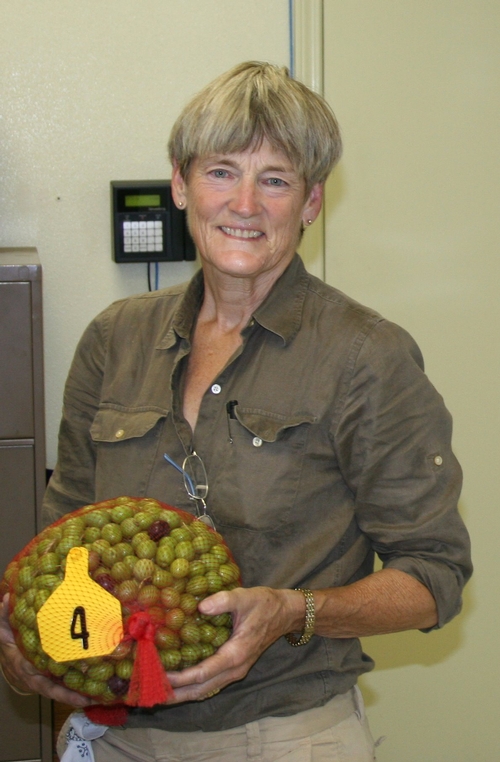
“I think mechanical harvesting will soon revolutionize the table olive industry,” said Ferguson, pomologist with the UC Davis Department of Plant Sciences and director of the UC Davis Fruit & Nut Research and Information Center.
Mechanical harvesters are commonplace for countless commodities, including olive oil olives. What is it about table olives that make them so hard to mechanically pick?
They bruise easily, for one thing, and bruised olives don’t cure well. Plus, table olives are harvested while still immature – unlike the more mature olive oil olives – so it takes more force to knock them off the tree. And then there is the tree canopy: Table olives trees tend to be wispy, less accommodating to mechanical harvesting than the high-density hedgerows you see in olive oil orchards.
Visit a typical table olive orchard and you will see the problem. It’s hard for a mechanical shaker to clean fruit off a tree that just sways, especially when that fruit is hard to dislodge in the first place. Plus, olive tree trunks get knobby with age (like the rest of us). If a machine rubs the bark off those knobs, it opens the tree to disease.
Scientists and engineers have been trying for decades to come up with a viable mechanical harvester. As with earlier attempts, a few versions designed and tested in the mid-90s didn’t pan out because they didn’t remove and capture enough high-quality fruit. But more recent efforts are showing great promise.
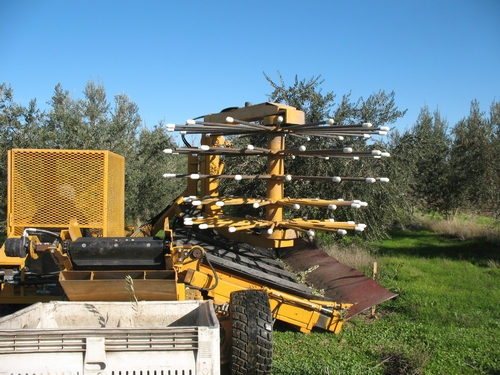
The two leading picking technologies are “canopy contact harvesting heads” (it resembles a huge hair brush) and trunk shakers. The canopy contact harvester can be used in existing orchards when they are pruned into a hedgerow and can also be used in the new high-density orchard Ferguson and her team designed, modeled after olive oil orchards. The trunk-shaking technology can be used in new high-density orchards but not in conventional orchards.
And here is the good news on fruit quality, the piece of the puzzle that now makes mechanical harvesting so promising: Even trained testers couldn’t tell the difference between manually and mechanically harvested table olives.
“That’s huge because fruit quality had always been a sticking point,” Ferguson says. “Jean-Xavier Guinard (sensory scientist with the UC Davis Food Science and Technology) worked with an expert panel trained to detect even the slightest defect in texture, taste, aroma – the works. They detected virtually no different between olives that were manually and mechanically harvested.”
More taste tests with both expert and consumer panels are in the works. In the meantime, several growers have decided to take the plunge. Burreson, for example, has planted 120 acres of table olives in the high-density hedgerows Ferguson helped design. In about five years, his olives will be ready for harvest.
So keep your fingers crossed as you enjoy your table olives, figuratively if not literally. It’s hard to keep your fingers crossed if eat them the old-school way, one at a time off each finger and thumb.

